Glamorgan, also known as Kittery Hill, is a large Queen Anne style house in Deer Park, Garrett County, Maryland. It is a large 2+1⁄2-story frame building built in 1888, as a summer house.

The Garrett Park Historic District is a national historic district located at Garrett Park, Montgomery County, Maryland. It's a 154-acre (62 ha) residential community incorporated in 1891, along the B & O Railroad. The older community includes a number of late Victorian homes. During the 1920s, the town expanded with a set of 40,640-square-foot (3,776 m2), "Chevy" houses built by Maddux, Marshall & Co. The district also includes a set of Prairie Style homes designed and built by Alexander Richter during the 1950s.

Hobson's Choice, is an historic home located at Woodbine, Howard County, Maryland. It is a five-bay, two-and-a-half-story rectangular brick house built about 1830, with a low-pitched gable roof and a recent low two-story frame rear wing. The woodwork is Greek Revival in influence.

The Captain Avery Museum is a historic home and museum at Shady Side, Anne Arundel County, Maryland, United States. It is a two-story frame building, located on a 0.75-acre (3,000 m2) rectangular lot. The house overlooks the West River and Chesapeake Bay. The two-story historic structure originally was the residence of the Chesapeake Bay waterman, Capt. Salem Avery, and was constructed about 1860. It was expanded in the nineteenth century and further expanded in the 1920s by the National Masonic Fishing and Country Club. The property consists of the main house with additions, three sheds formerly used as bath houses, and a modern boathouse built in 1993 that features the Edna Florence, a locally-built 1937 Chesapeake Bay deadrise workboat.
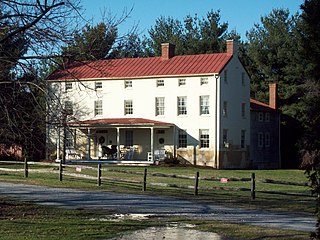
The Benson–Hammond House is a historic house located on Poplar Avenue in Linthicum Heights, Anne Arundel County, Maryland.

The Inns on the National Road is a national historic district near Cumberland, Allegany County, Maryland. It originally consisted of 11 Maryland inns on the National Road and located in Allegany and Garrett counties. Those that remain stand as the physical remains of the almost-legendary hospitality offered on this well-traveled route to the west.
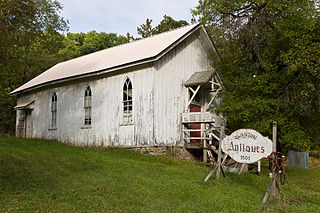
Anderson Chapel, also known as St. Paul's Episcopal Chapel, is a historic Episcopal church located at Swanton, Garrett County, Maryland. It is a late-19th century frame, one-story, gable-roofed church built in the Carpenter Gothic board-and-batten style. This style was popularized by the architect Richard Upjohn during the 19th century.
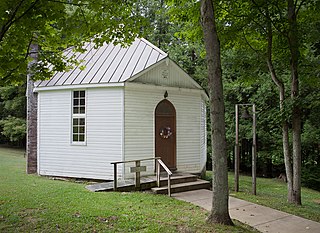
Mercy Chapel at Mill Run is an historic Carpenter Gothic-style church located at Selbysport, Garrett County, Maryland. It is a one-story, one room frame structure built on an octagonal plan above a coursed stone foundation. The interior of the chapel is a fine example of local craftsmanship and is virtually unchanged since the 1870s. Two small graveyard plots lie adjacent to the chapel. It is one of the most architecturally sophisticated and well-preserved octagonal buildings in Maryland, and one of only a dozen mid-19th-century octagonal buildings surviving in Maryland.

Oakland station is a historic railroad station located at Oakland, Garrett County, Maryland. It is a large brick structure with a two-story central section featuring a cylindrical tower with a domed cap and one-story wings extending from each end along the railroad tracks. It was designed by Baldwin and Pennington, and built in 1884 by the Baltimore and Ohio Railroad (B&O) across the tracks and a meadow from the Railroad's Oakland Hotel, which opened in 1876, to support the development of Oakland and Garrett County as a resort area. It is one of the finest remaining examples in Maryland of a Queen Anne style railroad station.
Borderside, also known as Brydon Mansion, was a historic home located at Bloomington, Garrett County, Maryland, United States. It was a 2+1⁄2-story, with 3-story tower, Italianate style brick structure that burned in the mid- to late 1970s. The tower had a pronounced bell-curve Mansard roof. It was built in 1870 for William A. Brydon, a coal and lumber dealer and member of the Maryland House of Delegates in 1867.

The James Drane House is a historic house located in Accident, Garrett County, Maryland, United States.
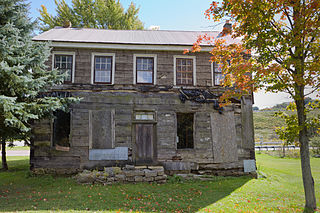
The Fuller-Baker Log House is a historic home located at Grantsville, Garrett County, Maryland, United States. It is a two-story rectangular log home, constructed of log planks about 8 inches (20 cm) thick; some are 14 to 16 inches (36–41 cm) broad and a few are 26 feet long. The house has been restored as an artist's studio and is an example of a log dwelling once common on the Allegheny frontier. Maryland's first governor, Thomas Johnson, owned the property when the house was built in 1815, but it is named for two later residents.
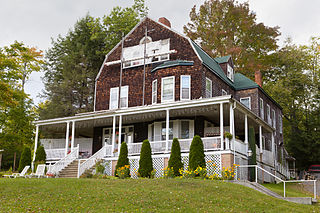
The Pennington Cottage is a historic home located at Deer Park, Garrett County, Maryland, United States. It is a 2+1⁄2-story, late-19th-century Shingle-Style frame structure, with a gambrel roof and a one-story porch that stretches across the principal facade and along portions of the sides. The house is entirely covered with dark wood shingles. It was built as a part of the Baltimore and Ohio Railroad's Deer Park Hotel complex, as the summer home of Baltimore architect Josias Pennington.

Kaese Mill is a historic grist mill located at Accident, Garrett County, Maryland, United States. It was constructed about 1868, and is a 2+1⁄2-story frame water-powered grist mill. It is the only fully operational water-powered grist mill in Maryland. It was built by Henry August Kaese, Sr., an immigrant miller from Germany who settled in Garrett County shortly after the American Civil War.

The Garrett County Courthouse is a historic county courthouse located at Oakland, Garrett County, Maryland, United States. It is a three-story, 1907–1908 neo-classical Renaissance Revival masonry structure in the form of a Latin Cross with a central rotunda and dome. The Courthouse was designed by James Riely Gordon (1863–1937), a New York architect who specialized in designing government buildings.

Mountain Lake Park Historic District is a national historic district in Mountain Lake Park, Garrett County, Maryland. It consists of a group of 145 buildings lying within the town, which was launched in the 1880s as a summer resort and important as a center of the Chautauqua movement in Maryland. The district still includes many of the houses built by summer residents of town in the late 19th and early 20th centuries, built in various interpretations of the "Country Gothic" or Rural Queen Anne styles. Also within the district are several of the educational and recreational buildings constructed by the Mountain Lake Park Association, the Methodist-led group which owned and managed the town for many years after its founding in 1881.
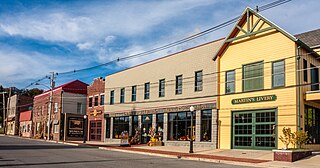
Oakland Historic District is a national historic district in Oakland, Garrett County, Maryland. It is an L-shaped area in the central and older section of Oakland containing 206 buildings. They reflect the evolution of this rural county seat from the mid-19th to mid-20th centuries. It includes the Garrett County Courthouse, but the majority of the buildings are residential of frame construction and positioned with deep setbacks from the street, surrounded by large lawns. Several churches and schools and a library are scattered in the district.

Mt. Pleasant, also known as the Clemson Family Farm, is a historic home located at Union Bridge, Carroll County, Maryland, United States. It is a five-bay by two-bay, 2+1⁄2-story brick structure with a gable roof and built about 1815. Also on the property is a brick wash house, a hewn mortised-and-tenoned-and-pegged timber-braced frame wagon shed flanked by corn cribs, and various other sheds and outbuildings. It was the home farm of the Farquhar family, prominent Quakers of Scotch-Irish descent who were primarily responsible for the establishment of the Pipe Creek Settlement.

Lansdowne, also known as Upper Deale or Lansdowne Farm, is a historic home and farm complex located at Centreville, Queen Anne's County, Maryland, United States. It consists of a brick dwelling, and a large barn, granary, and several outbuildings. The house was built in two distinct periods. The earliest house dates to the late colonial period and is a two-story, brick house, three bays wide and two rooms deep, with a single flush chimney on each gable. It is attached to a larger, Federal-period house built in 1823. The later house is brick, two and a half stories high, and was built directly adjoining the west gable of the earlier structure.
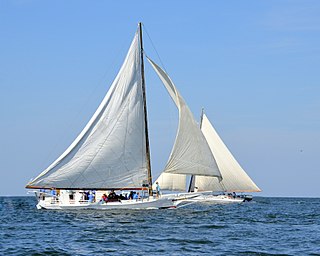
The Fannie L. Daugherty is a Chesapeake Bay skipjack, built in 1904 at Crisfield, Maryland. She is a 41.3-foot-long (12.6 m) two-sail bateau, or "V"-bottomed deadrise type of centerboard sloop. She is built by cross-planked construction methods and has a beam of 8 feet (2.4 m) and a depth of 3.6 feet (1.1 m). She one of the 35 surviving traditional Chesapeake Bay skipjacks and a member of the last commercial sailing fleet in the United States. She is located at Wenona, Somerset County, Maryland.






















